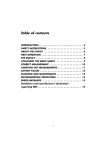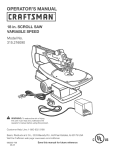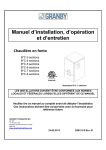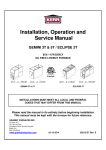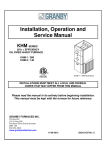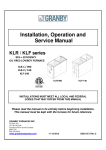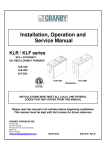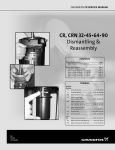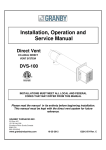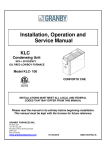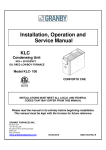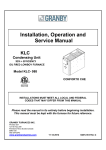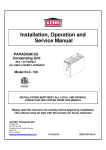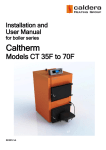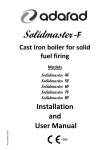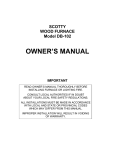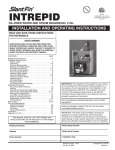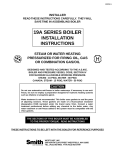Download BGC Manual - 2013-02-23 - E5 Rev B
Transcript
Installation, Operation and Service Manual Cast Iron Boiler SERIES B*C-3 sections B*C-4 sections B*C-5 sections B*C-6 sections B*C-7 sections B*C-8 sections B*C, 3 sections illustration INSTALLATIONS MUST MEET ALL LOCAL AND FEDERAL CODES THAT MAY DIFFER FROM THIS MANUAL Please read the manual in its entirety before beginning installation. This manual must be kept with the boiler for future reference. GRANBY FURNACES INC. PO Box 637 12118 Hwy 209 Parrsboro Nova Scotia Canada B0M 1S0 www.granbyindustries.com 02-23-2013 G2012-E5 Rev. B TABLE OF CONTENTS 1.0 IMPORTANT SAFETY ADVICE 2 2.0 PRODUCT INFORMATION 3 3.0 UNIT INSTALLATION 4 3.1 PLACEMENT & LEVELING OF THE UNIT 4 3.2 JACKET ASSEMBLY & CONTROL INSTALLATION 4 4.0 PIPING 8 5.0 ELECTRIC WIRING 11 6.0 CHIMNEY INFORMATION 12 7.0 FUEL SYSTEM 13 8.0 ACCESSORY INSTALLATION 15 9.0 BURNER INSTALLATION & SETTING 16 10.0 TECHNICAL INFORMATION 19 11.0 BOILER START UP & OPERATION 20 11.1 START UP PROCEDURE 20 11.2 L7248 HONEYWELL CONTROL 20 MAINTENANCE / SERVICE 22 12.1 CLEANING OF THE BOILER 23 12.2 BURNER CLEANING 23 12.3 PERFORM COMBUSTION TEST 23 13.0 EXPLODED PARTS VIEW 24 14.0 START UP TEST RESULTS 26 12.0 1 1.0 IMPORTANT SAFETY ADVICE Please read and understand this manual before installing, operating or servicing the furnace. To ensure you have a clear understanding of the operating procedures of the appliance please take the time to read section IMPORTANT SAFETY ADVICE of this manual. CAUTION DO NOT START THE BURNER UNTIL ALL FITTINGS, COVERS AND DOORS ARE IN PLACE. DO NOT TAMPER WITH THE BOILER OR CONTROLS, CALL A QUALIFIED BURNER TECHNICIAN. DO NOT STORE OR USE GASOLINE OR OTHER FLAMMABLE VAPOURS AND LIQUIDS IN THE VICINITY OF THIS UNIT OR ANY OTHER APPLIANCE. IMPORTANT This manual contains instructional and operational information for the B*C OILFIRED Boiler. Read the instructions thoroughly before installing boiler or starting the burner. Consult local authorities about your local FIRE SAFETY REGULATIONS. All installations must be in accordance with local state or provincial codes. Improper installation will result in voiding of warranty. 2 2.0 PRODUCT INFORMATION PHYSICAL DIMENSIONS Length : ( 3 sections 18 7/8 ‘’ ) ( 4 sections 22 1/2’’ ) ( 5 sections 26 ¼’’ ) ( 6 sections 31 1/8’’ ) ( 7 sections 35 ½’’) ( 8 sections 39 ¼’’) CLEARANCE Proper clearances must be maintained not only from combustible materials but also to provide adequate access for servicing. All installations must comply with local codes and CSA B139. Consult local fire codes for required clearances. Connections to chimney must be made with the proper gauge thickness and diameter of fluepipe as required by CSA B139. CLEARANCE (minimum) FOR SERVICING Front 24” Rear 24” Left Side 24” Right Side 2” Top 10” (609 mm) (609 mm) (609 mm) (50.8 mm) (254 mm) CLEARANCE (minimum) TO COMBUSTIBLES Top Front Rear Left Side Right Side Chimney Connector 10” 24” 24” 24” 2” 9” (254 mm) (609 mm) (609 mm) (609 mm) (50.8 mm) (229 mm) DRAFT PRESSURE Breech draft pressure 0.03’’ wc draft required FLUE PIPE CONNECTION CHIMNEY (see page19) or Direct Vent System DVS Granby kit ( 3,4,5 sections) 3 CLEANOUTS Rear removable smoke hood cover & Combustion Front Door Opening FUEL Not heavier than No,2 oil boiler ELECTRICAL 120 Volts, 60Hz 15 amps. fuse or breaker AIR SUPPLY CAUTION: Adequate air supply for both combustion and ventilation must be available. See page 14 for details. 3.0 Unit installation 3.1 PLACEMENT & LEVELING OF THE UNIT The boiler should be located on firm foundation in an easily accessible area that meets the previously discussed clearances and air requirements. In situations where the floor may be uneven the G*C may be level by using the leg levelers provided on the boiler or through the insertion of shims under the legs. Rail Adjustable Leg Leveler 3.2 JACKET ASSEMBLY AND CONTROL INSTALLATION The boiler jacket has been designed for ease of assembly and removal. The following step by step process will ease installation. A screw driver, 17 mm socket and ratchet or a 17 mm wrench or adjustable wrench are needed. 4 STEP 1 VERIFY CONTENTS OF JACKET ASSEMBLY PACKAGE. Your jacket assembly will contain two (2) manifolds with gaskets, a fastening package which includes all necessary bolts, screws, nuts and washers for assembly along with burner studs, nuts and washers, block insulation, rear of block insulation, aluminum faced tape, leveling frame rails, two (2) side panels, a rear panel top panel and re-insulated top and bottom front panels. STEP 2 FRAME RAIL CONNECTION Attach 10 mm bolts to the underside of the frame rails. These will be used to level the boiler. Screw the 4 mm jacket affixing screw to the frame rail from the top down. Both the bolt and affixing screw will be located on the same end of the frame rail. The frame rail will then be bolted to the legs of the boiler with the frame rail and containing the affixing screw facing in the direction of the front end of the boiler. STEP 3 MANIFOLD INSTALLATION Using the gaskets and bolts supplied connect the manifolds directly to the boiler block. The top supply manifold will have a 3/4” npt tapping for a relief valve and 1/4” npt tapping for a gauge. The bottom return manifold has 3/4” npt tapping for a drain vlave. Both manifolds have 1-1/4” male npt threads for sytem connection. 5 STEP 4 INSULATION INSTALLATION Drape the large piece of block insulation directly over the block taking care to provide adequate clearance from frame rails. Using the aluminum faced tape attach the preshaped rear inslulation to the block insulation. The process is simply taping the two pieces together. The front panels come pre-insulated. STEP 5 SIDE AND BACK PANEL ATTACHMENT Affix panel mounting nuts to the rear of the tie rods. Mount the side panels by placing the panel over the frame rail so that the hole in the bottom lip of the panel fits directly over the jacket affixing screw on the rail. You can then lock the panel in place by sliding it slightly forward. The slot on the rear of the panel will now be in position to slide over the tie rod at the rear of the boiler. Tighten the nuts on the tie rod end to firmly secure the panel. Repeat on the other side. Screw the back panel to the side panels. 6 STEP 6 CONTROL SENSOR ATTACHMENT Prior to jacket top and front panel installation the control sensor must be inserted into the brass well located on the top of the boiler and secured by a clip. Feed the sensor through the hole on the front of the right side panel from the outside. Penetrate the block insulation to insert the sensor. The sensor must be fully inserted to the bottom of the well. Manual Air Vent STEP 7 TOP AND FRONT PANEL ATTACHMENT Affix the top panel by placing the holes located on the underside of the panel over the jacket affixing pins. Press down on the top panel and it will snap in place. Affix the lower front panel by placing the openings on the lips of the panel over the jacket affixing screws and pushing downward on the panel. The panel will lock in place. Repeat the process for the top front panel. 7 Upon completion of the jacket assembly the control unit can be mounted on the side of the boiler. Honeywell control L7248 B*C, 3 sections boiler illustration The boiler is now ready for piping and connection to the fuel system, heating and domestic hot water, thermostat and 110 Volt 60 cycle AC current. CAUTION: Safety or relief valve discharge should be piped downward to within 6” of the floor or to a drain. The valve must be mounted in a vertical position. 4.0 PIPING Prior to connecting the B*C to an existing piping system certain procedures must be followed. The system should be flushed to insure that scale and sludge will not be introduced to the boiler. This is a must when replacing a gravity open system. The B*C is a low mass boiler requiring low water content and steps must be taken to insure that the boiler is not flooded from an existing high volume standing cast iron system. If the conversion is from a high volume system a bypass loop must be installed. Manual shut off valves must be installed on both the supply line and on the boiler bypass loop. ASME Boiler Code requires that feed or make up water be introduced to the piping system and not directly to the boiler. Pressure reducing valves should be installed and adjusted to 12 psi cold water. The pressure relief valve must be piped from the boiler and downward to within 6” of the floor or to a height to meet existing code. An expansion tank, circulating pump and automatic air eliminators must be part of the system. The relief valve, backflow preventer and drain valve should be piped according to code to a drain with piping that is the same size as the relief valve. All piping, including heating, domestic hot water and fuel lines must be done in accordance with all local codes. It is suggested that you refer to the Water Installation Survey and Hydronics Institute Residential Hydronic Heating Installation/Design Guide. All piping must be properly sized, free from defect and be made of copper, steel, brass, aluminum or PEX. 8 Circulation Pump A calculation for proper pump selection must be performed for all installations. The pump(s) should not be operated at maximum working pressures above 30 psi or maximum working temperatures above 200°F and within limits advised by the manufacturer. The pump must not be operated unless the system has been bled of all air and completely filled with water. Recommended locations for the circulator, expansion tank, relief valve and other trim are shown in Figure 1, Figure 2, Figure 3 and Figure 4. Figure 1 A typical installation with no domestic hot water and no by-pass loop installed. 9 Figure 2 A typical installation with no domestic hot water and with a by-pass loop installed. Figure 3 A typical installation with domestic hot water supplied by an indirect heater and with no by-pass loop installed. 10 Figure 4 A typical installation with domestic hot water supplied by an indirect heater and with a by-pass loop installed. 5.0 ELECTRICAL WIRING All external wiring must be performed in compliance with existing electrical codes within the local jurisdiction. In Canada the CSA, STANDARD C22-1 and the Canadian Electrical Code. Connections should be carried out in accordance with this manual and only by qualified individuals. • The boiler and burner should only be operated on 120 Vac. • Field connections should be properly sized and protected with a minimum 15 amp fuse or circuit breaker. • A separate fused disconnect must be installed as required by code so that power can be shut off for servicing. • The boiler must be ground to the water piping or the main service ground. The connections must be made in a manner to insure that there is no crossing of the neutral with the phase, a proper ground is provided and all three wires are connected to the operating control. 11 Typical wiring for line voltage oil burner with Honeywell L7248 and one heating zone. ( For Canadian application, see page 15 for proper wiring with a Block Vent Shut-Off ) 6.0 CHIMNEY INFORMATION Natural Draft Applications CAUTION: Oil fired units must always be connected to flues with proper draft. Specific guidelines should be followed to prevent the occurrence of the following conditions: • Reverse flow of flue gas during or after burner shutdown. • Positive outlet draft conditions. • Condensation of flue gasses 12 Chimney Connection To insure safe and efficient boiler operation flue gasses must be released through a clean, properly sized chimney with adequate draft that meets all local codes and regulations and be in accordance with CSA B139. Always inspect and clean the chimney to insure that it is free from obstructions. Never connect the boiler to a chimney or liner serving an open fireplace. A 6” diameter flue pipe must be used for connection of the boiler flue outlet to the chimney for the entire length of the connection. An exception can be made for the three, four and five section boilers where the flue pipe may be reduced to 5” for the length of the connection. The chimney connector should be at least 24 gauge metal, be properly supported and be free of as many 90 degree turns as possible. The distance between the boiler and the chimney depends on whether or not elbows are used. The distance should be at least 24” if no elbows are used and 12” if elbows are used. The same holds true for the maximum length of the flue pipe. It must be no longer than 10’ if no elbows are used and 6’ if elbows are used. Condensation The B*C Series boiler is a high efficiency boiler and as a result improper venting can lead to condensing temperatures in the chimney connector and the venting system. If condensing temperatures of below 250°F NET are reached in the chimney connector then additional steps to insure proper draft must be taken. Make sure that all joints are properly sealed with a high temperature silicone or mastic. If after sealing the joints the condition still exists then inspect the chimney for suitability. If the masonry, brick, block chimney or tile chimney liner is in poor condition a new chimney liner rated for oil may have to be installed. In the event the condition still exists after installation of a new liner consult Granby Industries. 7.0 FUEL SYSTEM The fuel system piping must comply with the pump manufacturers’ specifications which are included with the burner. In addition all fuel system piping must comply with local codes and ordinances. • The quality of your fuel is of great importance. designed to burn clean water free #2 fuel. For most instances your burner is • The oil supply line should be constructed of seamless heavy wall copper tubing with flared fittings. Only oil resistant pipe dope should be used on threaded connections. The use of Teflon Tape will void manufacturers’ warranty. Lines must be airtight, clean and free of kinks. All joints and threaded fittings must be checked for leaks. A vacuum gauge should be employed when testing the installation. It is recommended that older fuel lines be replaced. 13 • A two pipe system should only be used when the oil supply is well below the pump. A return fuel line may be used on inside installations where the tank level is below the level of the burner. The return line must be equal in diameter to the suction line. The minimum size for the oil line is 3/8” copper tubing. • A Tiger Loop is recommended when the oil supply line is located 5’ below the burner. • Shut off valves must be installed in the supply line at or near the oil storage tank and at the burner in compliance with all codes. Inspect the shut off valve spindle packing for tightness to insure that there are no air leaks. The valve must always be shut off if the burner is shut down for an extended period of time. The burner should be tagged to indicate that the fuel supply has been closed off. The electrical circuit to the burner must be cut off by removing the fuse or circuit breaker to insure that no operation of the burner will occur while the fuel supply is shut off. • Only fuel storage tanks bearing the Underwriters Laboratories label and accessories approved as prescribed by local code may be used. REAR FLUE BOILER ILLUSTRATION Draft regulator OIL TANK AND PIPING COMBUSTION & VENTILATION AIR Install openings and ductwork to the boiler room providing fresh out-side combustion and circulating air, as installation code require by Canada CSA B139. If installed in a closed room, provide two free air ventilation openings of at least 8’’ x 12’’ (96 sq in.) free flow areas near celling and floor. Oil burners must have sufficient air to allow vent system to operate properly. 14 8.0 ACCESSORY INSTALLATION BLOCKED VENT SWITCH (BVSO) FOR CANADIAN APPLICATION ONLY Oil-fired appliances installed in Canada require a blocked vent switch system when installed on a chimney. A safety switch is included with the furnace to perform this function. It is the installer’s responsibility to install the switch in accordance with the instructions provided. Not applicable for Direct Vent systems. Field Controls Model: WMO-1 (Manual Reset) Switch Operation Blocked vent switches are flue gas safety devices for detecting spillage of flue gases due to a blocked flue or inadequate draft. After detecting a problem, the switch de-energizes the system’s burner control. NEVER reset the switch unless the cause of the blockage has been corrected. Installation (Figure 1) 1) 2) 3) 4) 5) 6) Drill a 5/8” hole in to the flue vent pipe near the appliance breech connection. This hole must be before the draft regulator, vertically or horizontally. Remove one of the securing nuts from the threaded tube of the safety switch. Tighten the other securing nut onto the pipe as far as possible. Insert the threaded tube end into the pierced hole of the flue vent pipe. Install the securing nut on the safety switch tube, which protrudes into the flue vent pipe. Tighten the nut securely. Figure 1- Illustration from the instruction Figure 2- BVSO wiring diagram manual of Field Controls Wiring BVSO (Figure2) Caution: Disconnect the electrical power when wiring the unit. Wire the blocked vent switch in accordance with The National Electrical Code and applicable local codes. Wire the safety switch (BVSO) in series with the thermostat and the fan timer relay control (Figure 2). 15 System Test Procedure (BVSO) 1) With the power re-established, block the chimney or vent pipe downstream of the switch. 2) Adjust the thermostat to call for heat. 3) Once the heating system has started the blocked vent switch should shut down the burner within 10 minutes or sooner. 4) Once the system has cooled, the blocked vent switch can manually be reset. 5) This procedure should be tested a second time. 6) After testing the blocked vent switch the chimney should be cleared of obstruction and the heating system should be tested over a long run cycle. If the block vent switch shuts down the system, check to ensure there is enough draft in the chimney and venting pipes. 9.0 BURNER INSTALLATION AND SETTING ASSEMBLY & INSTALLATION OF BURNER ASSEMBLY Check that the burner model is correct for furnace rating required. Assemble as per burner manufacturer’s instructions. SELECT NOZZLE Select oil input, nozzle and burner configuration as shown on furnace operating decal. INSTALL NOZZLE Install selected nozzle, check for clean seating and tighten in nozzle adaptor. ELECTRODES See burner manufacturer’s instructions for correct setting INSERTION MOUNT BURNER Tighten top nut first so burner tips down slightly. The burner is always installed in an upright position by four (4) nuts. PUMP BY-PASS PLUG For one pipe system factory setting (no plug). 16 SET BURNER FOR EFFICIENT OPERATION BURNER SETTING Use burner settings in the table on page 19 or operating decal as a guide to set burner, particularly for nozzle changes. Those settings are only starting points for the adjustments and are not meant as final settings.. PUMP PRESSURE Refer to the table on page 19 or operating decal. AIR SETTING Use air settings on page 19 as a guide to set air adjustment. Those settings are only starting points for the adjustments and are not meant as final settings. DRAFT REGULATOR The draft regulator should be installed at least 3 flue pipe diameter from breeching or elbow of the furnace. SAMPLING HOLE On smoke/vent pipe, drill a 3/8” round opening. The hole should be at least 2 flue pipe diameter from breeching or elbow of the furnace. REAR FLUE BOILER ILLUSTRATION DRAFT PRESSURE Using an accurate draft meter; adjust the draft control to obtain -0.03” wc draft pressure at the breech sampling hole. The draft regulator’s adjustments should be made after furnace has been running under heating mode for at least 5 minutes 17 All your tests must be done with the burner cover on COMBUSTION SETTING/ EFFICIENCY After 10 minutes of normal operation, take a smoke test and adjust the burner to obtain a reading of “1” on the smoke scale. To reach the maximum smoke test value, a 10 full slow steady pump action is required. Take a CO2 test and note the result CO2 test can be done mechanically or electronically 18 full slow steady pump action Open the air band adjustment on the burner to reduce your CO2 lecture by 1% You now have a perfect “slight trace” of smoke. Relation between % of CO2 and O2 CO2 (%) O2 (%) Excess Air (%) 13.5 13.0 12.5 12.0 11.5 11.0 2.6 3.3 4.0 4.6 5.3 6.0 15.0 20.0 25.0 30.0 35.0 40.0 18 10.0 TECHNICAL INFORMATION B*C Cast Iron Boiler specifications Riello Burner 40 F3 Unit Model Number of sections Firing Rate (USGPH) Input (BTU/h) Output (BTU/h) Nozzle Pump Pressure (psi) Turbulator Setting Air Gate Adjustment Energy Star Approved AFUE (%) CO2 (%) 40 F5 40 F10 B*C – E6-0085-** B*C – E7-0121-** B*C –E7-0152-** B*C – E7-0174-** B*C – E8-0194-** B*C – E8-0224-** 3 SECTIONS 4 SECTIONS 5 SECTIONS 6 SECTIONS 7 SECTIONS 8 SECTIONS 0,7 98 83 0,55 70B 160 0 3.6 YES 88.2 13 1 140 121 0,85 60B 140 2 2.8 YES 88.3 13 1,25 175 151 1,00 60W 156 3 3.0 YES 88.4 13 1.39 194,000 167,000 1.10 60W 160 2 4.8 YES 88.4 13 1.60 224,000 195,000 1.35 45B 145 1 3.0 YES 88.5 13 1.80 252,000 222,000 1.50 45B 145 2 3.0 YES 88.6 13 (*) In the Unit Model number, is specific information of the product for administration only. • ** Honeywell control L7248 (high limit only, cool start application) GRANBY B*C CAST IRON SERIES Appliance Model B*C – E6-0085-** B*C – E7-0121-** B*C –E7-0152-** B*C – E7-0174-** B*C – E8-0194-** B*C – E8-0224-** No. de section Length (inches) Shipping weight (lbs) 3 18-7/8" 4 Water Content (gal.) Supply Outlet (inches) Return Outlet (inches) 370 5.5 1-1/4" 1-1/4" 22-1/2" 437 6.9 1-1/4" 1-1/4" 5 26-3/4" 503 8.2 1-1/4" 1-1/4" 6 31-1/8" 569 9.5 1-1/4" 1-1/4" 7 35-1/2" 639 10.8 1-1/4" 1-1/4" 8 39-3/4" 705 12.2 1-1/4" 1-1/4" WARNING: Do not operate if any controls have been submerged. Contact a qualified technician for inspection prior to use. 19 11.0 BOILER START UP AND OPERATION 11.1 START UP PROCEDURE • Prior to start up make sure the service switch is in the OFF position. • Check all fittings and wiring. • Insure that the boiler and the entire heating system are completely filled with water and that all air has been purged from the system resulting that proper system pressure is achieved. The minimum PSIG is 12. • Check to insure that clean quality #2 heating oil has been used to fill your storage tank. • Open all manual shutoffs throughout the system. • Set operating controls to the recommended settings. • Follow the burner manufacturer’s instructions for proper light off and setting. Using accurate combustion test equipment set the burner for proper “steady state” operation. The use of accurate instruments is necessary to achieve maximum efficiency and lowest fuel costs. • Adjust the thermostat to manufacturer’s instruction • Place this manual, the control manual and the burner manual along with related consumer information in an easily accessible location. Installers should make the consumer aware of the content and location of this information. 11.2 Honeywell control L7248 Adjusting Settings To discourage unauthorized changing of Aquastat settings, a procedure to enter the ADJUSTMENT mode is required. To enter the ADJUSTMENT mode, press the UP, DOWN and I buttons simultaneously for three seconds. Press the I button until the feature requiring adjustment is displayed. Then press the UP and/or DOWN buttons to move the set point to the desired value. After 60 seconds without any button inputs, the control will automatically return to the RUN mode and lock the setting. 20 TROUBLE SHOOTING L7246 When attempting to diagnose system performance, reference to the LED display can help to identify specific areas not working properly. The LED display will scroll ERR, followed by a digit (1-8). Refer to the information inside the cover of the control L7248. Error Codes Err 1 Err 2 Err 3 Err 4 Err 5 Err 6 Err 7 Err 8 Sensor fault ECOM fault Hardware fault B1 fault Low line Fuse EEPROM Multiple Err 4 Check sensor Check Optional EnviraCOM wiring Replace control Check B1 wiring/voltage Checl L1 - L2 > 110 V a/c Check ECOM wires, replace fuse Reset limit values Press/Hold I for 60 sec min* System Condition Diagnostic Condition Boiler is cold, house is cold. Display is OFF 120 V a/c System power. Turn system power on Display is ON 24 V a/c T-T 24V present; disconnect thermostat, short T-T 120 V a/c at B1-B2 No 24 V; replace control Boiler is not, house is cold. Display is ON. Check 120 V a/c at C1-C2 Action Boiler starts, check wiring and thermostat. . If no, replace control. . If yes, check burner and wiring. . 120 V a/c at C1-C2, check wiring to pump. Wiring OK , is pump running ? . If not, replace the pump. . If pump is running, check for trapped air or closed zone valves. TESTING SAFETY AND CONTROL DEVICES In the event the boiler is equipped with a low water cut off, the cut off should be tested in accordance with the manufacturer’s recommendations. When no instructions are available follow the guidelines in ASME CSD-1 or perform the following procedures: • • • • Set room thermostat at least 10°F above room tempe rature. With Burner operating, drain boiler slowly until the burner shuts off. This shut off should occur when the water level falls below the low water cut off probe. Check to be sure the burner shut off is not due to an open limit or flame safety issue. Reset the room thermostat to the desired temperature and refill the boiler 21 12.0 MAINTENANCE / SERVICE Your heating appliance is designed to be maintained and serviced only by your heating professional. The following sections provide information on maintenance and service related activities. In the event a problem occurs consult your heating professional. • In addition to higher efficiencies the B*C Boiler feature removable baffles Model nd rd # Of Baffles 2 Pass 3 Pass 3 Sections 4 X X 4 Sections 4 X X 5 Sections 2 X 6 Sections 2 X 7 Sections 2 X 8 Sections 2 X CONDENSATION If you have condensation in your chimney, make sure that the chimney size is according to the tables in CSA B139. The temperature at the entrance of the chimney can be increased by insulating the flue-pipe between the furnace and the chimney base. If this is not sufficient, consider cutting or removing some flue baffles in the furnace. BE AWARE THAT REMOVING BAFFLES REDUCES THE UNIT EFFICIENCY AND A MODIFIED UNIT IS NO LONGER ENERGY STAR APPROVED. HOMEOWNER SERVICE CAUTION In the event of a problem with the heating system the homeowner should perform the following limited activities. • Check to make sure that there is fuel in the tank and that oil valves are open. • Set the thermostat above existing room temperature. • Check for blown fuses or circuit breakers and make sure power switches are in an on position. • NEVER TAMPER WITH CONTROLS, WIRING OR PIPING ! 22 12.1 CLEANING OF THE BOILER Section cleaning should only be performed by a service technician and must only be performed when the boiler is out of service. The following steps should be followed: • Remove the 2 front panels by sliding it upwards to release and then pull to remove. • Open the front swing door by removing the four bolts; this will expose the chamber area as well as the second and third passes. (A) • Remove the stainless steel baffles. With a cleaning brush clean the boiler section, second and third passes. (B) • Remove insulation and the smoke hood cleaning access door from the rear section. Remove any soot that may have collected in the smoke hood. (C) Baffles cleaning access door C A B • C Replace insulation on the rear section and smoke hood. • Replace swing door and tighten bolts. • Refit the front casing. 12.2 BURNER CLEANING Your burner manufacturer has supplied instructions for servicing and maintenance should be performed as instructed. In addition the following fuel and related items should be serviced on a regular basis: • • • • • Service fuel filters and fuel unit. Service burner housing and fan. Replace nozzle using only the size and type recommended by the boiler manufacturer. Service ignition system. Perform testing and check for proper operation of the primary control. 12.3 PERFORM COMBUSTION TEST The burner must be adjusted to insure proper CO2 levels with no more than a slight trace of Smoke. Continue adjustments until the proper level is achieved. See page 18 23 13.0 EXPLODED PARTS VIEW Exploded Parts View 24 Part List 1 G*C FRONT SECTION 60 GC PNA - POCKET FOR SENSING BULBS 2 G*C INTERMEDIATE SECTION 67 TAPPING WITH AIR RELIEF VALVE 3 G*C REAR SECTION 68 REAR CASING 4 NIPPLE 83 SPECIAL PIN FOR CASING ASSEMBLY 5 STAYBOLTS 86 FIBRE-GLASS ROPE DIA. 10 6 BODY INSULATION 87 HINGE PIN 9 FRONT DOOR (MONOBLOCK) 88a HINGE - LEFT HAND SIDE 11 FRONT INSULATION 88b HINGE - RIGHT HAND SIDE 15 RUBBER GASKET 89 OUTLET FOR PRESSURE MEASUREMENT 19 REAR INSULATION A SETSCREW M10 x 30 20 SIGHTGLASS FRAME B WASHER A10.5 21 SIGHTGLASS C NUT M10 22a SIGHTGLASS FRAME INSULATION D STUD M10 x 40 22b SIGHTGLASS INSULATION E NUT M8 24 FRONT DOOR REFRACTORY F WASHER A8.4 25 / 27 / 29 2ND PASS RETARDERS G SETSCREW M5 x 15 26 / 28 3RD PASS RETARDERS H NUT M6 30 DELIVERY STUB PIPE J WASHER A6.4 31 RETURN STUB PIPE K STUD M6 x 22 44 BLANK FLANGE L SELF TAPPING SCREW S6.3 x 30 47 SMOKEHOOD DIA.150 MM M SERRATED WASHER A4.3 50 SMOKEHOOD CLEANING COVER INSULATION N NUT M4 51 SMOKEHOOD CLEANING COVER P SELF TAPPING SCREW S4.8 x 9.5 53 CHASSIS - LEFT/RIGHT HAND SIDE R WASHER A6.4 54 SIDE CASINGS - LEFT/RIGHT HAND SIDE S SETSCREW M3 x 6 55 FRONT CASING LOWER PART U WASHER A9 56 FRONT CASING UPPER PART V STUD M8 x 50 57 ÜST SAC Y SETSCREW M8 x 16 58 BOILER DATA PLATE Z SETSCREW M8 x 30 PARTS NOT ILLUSTRATED AA HONEYWELL L7248 - AQUASTAT CC PRESSURE VALVE (30 lbs) BB PRESSURE – TEMPERATURE GAGE DD DRAIN VALVE 25 14.0 START-UP TEST RESULTS Model: Serial Number: Boiler, # sections Date of installation: Installer (name & address): TEST RESULTS Size of unit (Btu/h): Nozzle: Oil Pressure (psi): Chimney size ____________ Direct vent system (DVS) _________ Burner adjustments: RIELLO F3___ BF3___ Turbulator: RIELLO F5___ BF5___ RIELLO F10____ Air Gate: Smoke result: #0_______ TRACE______ Combustion Results: CO2 % Chimney draft: “ W.C. Ambient temperature: °F Gross flue temperature: °F 26 Granby Furnaces Inc. manufactures a full line of oil-fired boilers in its 70,000 square feet facility. Granby products are sold across Canada and the United States through a distribution network. Our team of engineers, designers and technicians continually research and develop products to go beyond the demanding specifications of today’s certifications. Thank you for choosing Granby. Granby. 27




























